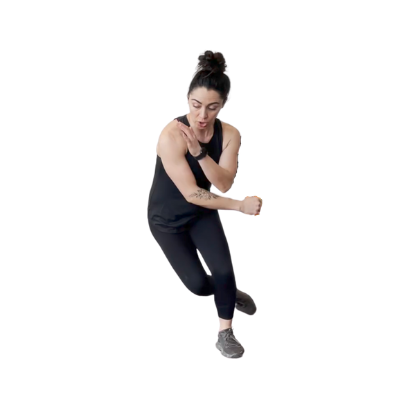Exercise Tutorial: Speed Skaters
Table of Contents
What Are Speed Skaters
Speed Skaters, also commonly referred to as Skater Jumps, are a great plyometric exercise that targets the cardiovascular system as well as increases lower body strength and power. This bodyweight exercise requires little space and no equipment, making it the perfect exercise to add to your exercise routine.
How to Do Speed Skaters
From a standing position, with feet about hip-width apart, slightly bend at the hip and knees to come into a ¼ squat position. Shift your weight to your right leg and raise your left leg off the ground.
Laterally bound to your left by pushing off with your right foot
Try to land softly on your left leg, similar to your starting position, allowing your right leg to cross behind you and your right arm to cross in front of your body, mimicking a “speed skater”
Upon landing, briefly pause to gain stability and control and jump in opposite direction, this time taking off with left leg
Repeat bounding back and forth for desired # of reps
Speed Skaters Form
Speed Skaters are a dynamic exercise that can be performed at a high intensity. Asa result, it’s important to not compromise form for speed. Here are some things to think about when performing the exercise:
Landing on a balanced foot
Weight over midfoot -> not shifting on sides of foot or on heels/toes
Hip, ankles and knees in alignment
Neutral spine -> no rounding of the back
Speed Skaters Benefits
There are many benefits to performing Speed Skaters. Some include:
Improved cardiovascular fitness
Improves lower body strength and power
Can be incorporated into HIIT workouts or circuit training
Improved muscular endurance and speed
Enhances agility and stability
Doesn’t require equipment
Speed Skaters Muscles Worked
Quadriceps
Hamstrings
Hip Flexors
Core
Speed Skaters Variations
MB Speed Skaters
For the MB Speed Skaters, we are performing the exercise the same way we are just simply adding a load to increase the intensity of the exercise. We start by holding the MB in front of our chest and swing it front of us from armpit to armpit as we jump. Almost bringing it into the side pocket of your arms as if you’re protecting the ball.
Short and Long-Distance Speed Skaters
Like the previous variation, the long and short distance Speed Skaters are performed the same way as the conventional Speed Skater, we’re simply modifying the distance. If performing more quick jumps across a shorter distance, our focus is more on speed and muscular endurance. The greater the distance, the less reps completed and the more plyometric the exercise becomes as we now have to generate that power to cover the increased distance, resulting in less reps.
Speed Skaters with Hand to Foot/Floor Touch
This variation is similar to the conventional Speed Skater, the only difference being is instead of crossing our one arm in front of our body, we touch opposite arm to opposite foot, or the floor i.e. left arm reaches down to touch right foot or the floor.
TRX Speed Skaters
TRX Speed Skaters, also commonly known as TRX Skater Jumps, are a great variation to the conventional Speed Skaters. They are performed essentially the same as the original Speed Skaters, with the main difference being holding onto the handles of the TRX while bounding laterally. Simply grab the handles and step back until there is tension on the band and perform the Speed Skater as usual. This is a great variation for beginners as it provides a little more stability and takes some of the load of the knee.



